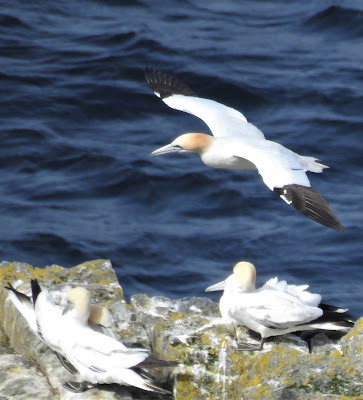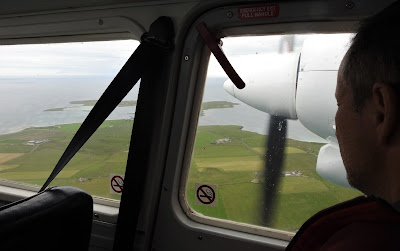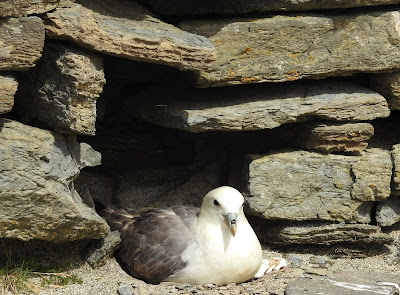We flew direct to the old viking settlement of the Shetland Islands - closer to Norway than England.
We arrived in the capital Lerwick in time for an evening stroll.
Greeting us in the harbour, a tame old bull Grey Seal (Halichoerus grypus) - one of the two species of seals that breed in Britain. He was swimming around a small boat preparing to leave harbour. The skipper told us he throws him fish.
Fishing alongside was our first Arctic Tern (Sterna paradisaea) - taking its catch to its young, which was calling from the jetty.
The next morning we drove on the mainland to Eshaness, on our way to the island of Unst in the far north.
Stenness is an old fishing harbour.
From here you can look across to Dore Holm, which looks like a drinking horse.
The cliffs here are the remains of the edge of an ancient volcano.
Throughout the Shetlands we saw many Meadow Pipits (Anthus pratensis), digging out insect larvae and cramming as many as they could into their beaks.
Also prodding in the fields, Oyster Catchers (Haematopus ostralegus).
And a lone Redshank (Tringa totanus) down on the shore.
By evening, we had taken two ferries to take us to the island of Unst - the most northerly settlement on the United Kingdom. We stayed in the far north of the island at Saxa Vord - an old RAF radar station, closed in 2006, where the 'red peril' was monitored during the Cold War.
Early next morning we crossed to the north-west peninsula, to the Hermaness Nature Reserve - and a welcome coffee in the old lighthouse, now a visitors centre. Their display gave a foretaste of what to expect.
We walked across the reserve Blanket Bog. 5,000 years ago Shetland was covered in scattered birch trees, which were cut by settlers. With lowering temperatures and increased rain, the soil minerals leached through the bare acidic soils, iron was deposited under the soil as impermeable 'pans', and waterlogging began. This was the end of agriculture, and the settlers. Sphagnum moss then colonized, which further increased the acidity of the soils.
The bogs were speckled with Cotton Grass (Eriophorum angustifolium) which loves acidic peat. Some call it Bog Cotton. It is not actually a grass, but a sedge - identified by the triangular shaped stems.Low oxygen and acidity killed the bacteria which normally break down dead plants, which instead compacted to form peat.The energy trapped in peat may not be available for agriculture, but the peat can be cut and burnt for heat. Peat fires are used to dry malted barley, which gives Scottish whiskeys their 'smoky' flavour.
The grass around the bogs is grazed by sheep, which take shelter in the depressions...
...and by wild rabbits.
Flying over our heads, the famous 'Bonxies' - local name for the Great Skua (Stercorarius skua).
They nest in the blanket bog. There are over 700 pairs on the reserve - about 5% of the world's population, which is restricted to the north-east Atlantic. When nesting, Bonxies vigorously defend their territories, and will dive-bomb passers-by. No attacks for us, as the chicks had fledged. Bonxies are aerial pirates, plundering fish catches from other seabirds.They seem to spend a lot of time bathing in the bogs.
We walked to the coast, where sheer cliffs up to 170m high are a refuge for seabirds which come in from the sea in summer to breed. You don't come here to see numbers of species, you come to see numbers of a species. In the distance you can see white on the rocks. Not the remnants of snow, but guano (or bird shit as it's otherwise known).
A closer view reveals huge gannetries.
The ganneteries continue up to the lighthouse on Muckle-Flugga, and on to the small rock beyond, Out Stack, the most northerly point in the United Kingdom.
The first gannets arrived here only in 1917, and now there are 16,000 pairs. We watched the Gannets fly off from the rocks over the cliffs and then dive for fish. They can dive from a height of 30 metres, achieving speeds of 100 kilometres per hour as they strike the water, enabling them to catch fish much deeper than most airborne birds. The fluffy white chicks cuddle up to their mothers.
On the water a raft of Atlantic Puffins (Fratercula arctica). They spend their winters like this, far out at sea - travelling as far west as Newfoundland.
But each Spring they return to their same burrows in the soft turf along the cliff tops. At Hermaness there are between 20,000 and 30,000 pairs. They feed manily on sand eels, and the availability of these will determine chick survival rates and therefore population numbers. Their latin name, Fratercula, means friar - a reference to their black and white plumage which resembles monastic robes. There's nothing like getting up close to a Puffin.
Leaving the reserve, and looking along the shoreline, we saw a number of gulls paddling. The Common Gull (Larus canus)...
...Herring Gull (Larus argentatus)......and if you thought gulls were never nasty, take a look at the expression of this Great Black-backed Gull (Larus fuscus). I once saw one in Norway catch a Puffin in mid-air and pull it apart on the ground.
No such bad behaviour from the Ringed Plover (Charadrius hiaticula).
On the ground, a Northern White-tailed Bumblebee (Bombus magnus).
I suppose I have to show a photograph of a Shetland Pony.
We had some time to spare before our flight to the Orkney Islands, so we visited Sumburgh Head, at the southern tip of Shetland - next to the airport.
It showed us you don't have to travel far in Shetland to see good wildlife - you could walk from the airport!
Dan communed with a Puffin.
You can never see too many Puffins.
Here we had our best views of a close relative of the Puffin (another member of the Auk family) the Guillemot (Uria aalge). Most have all black heads, but you will see one with a white streak behind its eyes. This is a 'bridled guillemot', a polymorphic form controlled by a single gene. Bridled Guillemots are more common the further north you go. In northern Scandinavia and Iceland they are the most common form, where they breed alongside the similar Brünnich's Guillemot (Uria lomvia). The 'bridle' may have been selected as 'character displacement', enabling members of the same species to recognise each other in packed mixed species colonies. Note the cute chick, bottom left.
As they say, there's nothing like a good Shag (Phalacrocorax aristotelis). Here they sit on the algae-covered rocks at sea level, spreading their green-tinged sheen of their wings.
Sumburgh Head lighthouse is a great lookout post for flying skuas. Here we had our only views of Arctic Skua (Stercorarius parasiticus).
Further along the coast, the Arctic Terns hovered in search of fish.
Just to the north-west of the airport, the Bay of Scousburgh.
On the northern beach basked Harbour Seals (Phoca vitulina), the second of the seal species.
A young seal seemed to be copying its mother, until it got thirsty.
In the bay, a Red-throated Diver (Gavia stellata) - or ‘raingoose’, as it is
known locally. There are around 900 breeding pairs of red-throated divers in Britain, all in Scotland, with more than half nesting in Shetland.
Back to Sumburgh airport, and our flight to Kirkwall - capital of Orkney.
A transfer to a six-seater, and we were on our way over the islands to North Ronaldsay - the most northerly island in the Orkneys.
We checked into our lodgings in the bird observatory, at the south of the island. Great place, with a great group of volunteers looking after us.
As the island is only 3 miles long, it's no hardship to walk around its coastline.
The island is encircled by a dry stone dyke,12 miles long and 6 feet tall, built in 1832 to stop sheep from going to the shore and eating the seaweed - which was harvested for iodine. When seaweed farming became uneconomical, the sheep were banned to the coast side of the wall to live off the seaweed - instead of competing with the more valuable cattle and damaging crops!
North Ronaldsay Sheep are an ancient breed, belonging to the Northern European Short-tailed group.
One of the joys of the island is that nature seems to care little of your presence. Harbour Seals barely looked up from their lounging as we walked past.
Eiders (Samoteria mollissima) move along the waters edge.The male has already lost his bright white, green and black summer breeding plumage.
The female is now too busy with her chicks to care about how attractive the male looks. Her nest would have been lined with feathers plucked from her breast - eiderdown.
Other ducks, Common Scoters (Melanitta nigra), fly past off-shore. They are usually only seen as flocks in the distance.
The ornithologists at the observatory had put up nests to catch and monitor migrating Linnets (Linaria cannabina), but weren't having much luck. We saw this one on the shore, looking as though it had just landed after a long flight.
Inside of the dykes are fresh water pools. We saw Red-necked Phalaropes (Phalaropus lobatus) wading - a rare sight. They breed mainly in Iceland, and these ones are still in breeding plumage with their bright red-necks. In Phalaropes, the sex roles are reversed. Females are larger and more brightly coloured than males, they pursue males, and will defend their mate from other females. After egg-laying the females may attempt to find another mate and, when it is too late in the season to start a new nest, migrate south to the tropical Arabian sea for the winter - leaving the males to incubate the eggs and look after the young. As biology teaches us us, there is no right or wrong way - only the way that works.
Inside of the dykes are fresh water pools. We saw Red-necked Phalaropes (Phalaropus lobatus) wading - a rare sight. They breed mainly in Iceland, and these ones are still in breeding plumage with their bright red-necks. In Phalaropes, the sex roles are reversed. Females are larger and more brightly coloured than males, they pursue males, and will defend their mate from other females. After egg-laying the females may attempt to find another mate and, when it is too late in the season to start a new nest, migrate south to the tropical Arabian sea for the winter - leaving the males to incubate the eggs and look after the young. As biology teaches us us, there is no right or wrong way - only the way that works.
In the fields, a mean bull sits guard.
Outside the New Church, Northern Marsh-orchids (Dactylorhiza purpurella) are in bloom. (Though, with the spotted leaves, it may be a hybird with the Heath Spotted-orchid (Dactylorhiza maculata)).
The walls around the fields on North Ronaldsay sing. Deep inside are the nests of Starlings (Sturnus vulgaris).
A summer visitor, the Northern Wheatear (Oenanthe oenanthe).On the north coast, at Dennis Head, the Old Beacon - built as a lighthouse in 1789, but extinguished in 1809 when nearby lighthouses were considered sufficient. The beacon chamber at the top was replaced by a vaulted roof, capped by a remarkable ball finial.
A new lighthouse was built nearby at Point of Sinsoss in 1852. It is Britain's tallest land-based lighthouse tower. But more important, it serves tea and cakes!
On a lake between the lighthouses a Little Tern (Sterna albifrons) perches, already having lost it's breeding colours of yellow bill and orange legs. Soon it too will make the long flight to Africa for the winter.
I told Richy I was looking for a wren, but couldn't find one. Then he told me he'd just taken this fabulous picture of one on a wall outside the observatory. It even has a ring on its leg. Time to move on.
A flight back to Kirkwall, a bus to Stromness, and then we hire bicycles and take them on the ferry to Hoy.
We approached an unusually hilly landscape.
Then cycled 'all among the purple heather'.This is clearly a Heath Spotted-orchid.
Plenty of Magpie Moths (Abraxas grossulariata) were scattered across the heather.
Cycling past the bracken we heard the 'chip chip' of the Stonechats (Saxicola rubicola), which nest in the heather.And more and more Meadow Pipits.
On the other side of the island, Rackwick - our home for the night in the small hostel.
On the beach is a small bothy, with a wood fire, where some people were sleeping. We sat outside, watching the fish jumping in the evening light.
Next morning, a walk up to the 'Old Man of Hoy' (that's the one on the left).
Sheer pink cliffs rise up from the sea, and Fulmars find a place to nest among the green of the ledges.We watched them glide around us, like the small albatrosses they are.
On my wall at home I have a collage made by my university zoology classmate, wildlife artist, and friend, Greg Poole. I think he really captured the circular motion of the Fulmars gliding from ledge to ledge. You can see his art at gregpoole.co.uk.
Walking back to Rackwick, a Green Tiger Beetle (Cicindela campestris) on the path. They love the dry sandy soils of heather moorlands, where they run very fast to catch their prey.
Early morning, waiting for the ferry to take us back to Stromness. The light was pure, the water clear.
From Stromness, a diversion north to visit Skara Brae, a prehistoric village nestled in the Bay of Skaill.
The village consists of eight houses, occupied from around 3180 to 2500 BC. That means it is older than Stonehenge and the Great Pyramids. It was unearthed by a violent storm in 1850.
To the south, a short finger of land is being excavated. There, between two groups of standing stones, is the Ness of Brodgar - a neolithic settlement dating back before 3000 BC.
At the harbour in Stromness, there is a shed where live lobsters are stored. We bought this magnificent beast, and took him on the bus with us back to Kirkwall.
At our Youth Hostel, chef Dan cooked up a fine lobster dinner - which we washed down with local Highland Park whiskey.
The time came to leave the Islands, and return to the mainland. In the departure lounge at Kirkwall airport there are a number of collages featuring the wildlife habitats of the island. I think they really capture the moods.
From Inverness airport, a drive to the Cairngorms in the Highlands.
We walked in the woods looking for Scottish Crossbills, but saw none. Just a Treecreeper (Certhia familiaris)...
...and a young Robin.
There are around 500 species of butterflies in Europe, but only 30 are resident in the cold northerly latitudes of Scotland. The Ringlet (Aphantopus hyperantus) is one of them.
And, scuttling across the forest floor, the last beastie of the trip - a black carabid beetle, Carabus glabratus. A relative of the Tiger Beetle, it is also a fierce predator - and, in its own way, just as magnificent as the gannets nesting on the rocks at Unst.
What better way to end our trip than a wee dram and a sing-song in the Captain's Bar, Edinburgh.



































































































































































